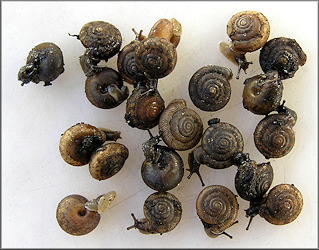Reproduction
As Daedalochila delecta is a fairly
recently discovered organism, there isn’t much information known
on its specific life history and reproduction. Therefore, the
information given here on Daedalochila delecta’s
reproduction is generalized to its genus (Daedalochila)
and family (Polygyridae).
Snails in the Polygyridae family are all monoecious, meaning
that one organism contains both male and female sexes, and
usually reproduce at night (Branson,
1962). This means that
three functions must be fulfilled by the reproductive structures
present: 1) Production of one’s own sperm 2) Receipt of foreign
sperm 3) Production of eggs (Wilbur,
1985). Snails of this
family have 26 to 35 haploid chromosomes (Barker,
2001).
Although reproduction is sexual and they can fertilize
themselves, they can also fertilize each other’s eggs with an
exchange of spermatophores (bundles of sperm), which leads to
diversity in the species because of cross-fertilization (Hickman, et al., 2009). This method is preferred, and
self-fertilization usually only occurs under harsh conditions.
When the eggs are laid, they look like a mass of jelly-like
globules and are laid in moist localities where they are
protected from the sun and won’t be disturbed, most likely on
the underside of damp vegetation or under logs (Baker, 1939).
Most snails lay their eggs between May and June, and on average,
twenty days later these young snails hatch and start their
lives. They will reach maturity around two years later
(Baker,1939).
